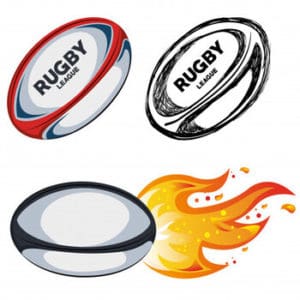Speed is one of the most electrifying attributes in rugby union. The ability to outrun defenders, chase down opponents, and turn half-chances into tries separates the elite from the rest. In 2025, the sport is blessed with several lightning-quick players who consistently leave defenders trailing in their wake. This article highlights the fastest rugby union players, analyzing their top speeds, playing styles, and impact on the game.
1. Louis Rees-Zammit (Wales)
Top Speed: 10.5 meters per second (37.8 km/h)
Louis Rees-Zammit has established himself as one of the quickest wingers in world rugby. The Welsh flyer combines acceleration, agility, and top-end speed to devastating effect. His ability to turn defense into attack within seconds makes him a nightmare for defenders. Rees-Zammit has consistently demonstrated his pace on the international stage, making him a crucial asset for both Wales and Gloucester Rugby.
2. Cheslin Kolbe (South Africa)
Top Speed: 10.3 meters per second (37.1 km/h)
Despite his relatively small stature, Cheslin Kolbe is one of the most elusive and rapid players in rugby. Known for his breathtaking sidesteps and blistering acceleration, Kolbe has been a key player for South Africa. His pace allows him to beat defenders in one-on-one situations and create try-scoring opportunities from almost anywhere on the field.
3. Darcy Graham (Scotland)
Top Speed: 10.1 meters per second (36.4 km/h)
Scotland’s speedster, Darcy Graham, has developed into a lethal finisher with the ability to exploit space with ease. Playing for Edinburgh and the Scottish national team, Graham has showcased his impressive speed, particularly in counterattacks. His quick feet and ability to change direction at pace make him an unpredictable and dangerous runner.
4. Will Jordan (New Zealand)
Top Speed: 10.2 meters per second (36.7 km/h)
Will Jordan has been a revelation for New Zealand with his blistering pace and clinical finishing. The All Blacks’ fullback and wing has an uncanny ability to find space and accelerate past defenders. His speed is complemented by intelligent running lines and superb positioning, making him a constant try-scoring threat.
5. Henry Arundell (England)
Top Speed: 10.4 meters per second (37.5 km/h)
One of England’s brightest young talents, Henry Arundell has quickly made a name for himself with his exceptional pace. The explosive back has demonstrated his ability to outrun entire defensive lines, scoring some of the most memorable solo tries in recent years. His top speed makes him one of the most exciting players in modern rugby.
6. Rieko Ioane (New Zealand)
Top Speed: 10.0 meters per second (36.0 km/h)
Rieko Ioane has been one of the fastest All Blacks since his debut. His combination of strength and raw speed allows him to break tackles and outrun opponents with ease. Whether playing as a center or winger, Ioane remains a major attacking weapon for New Zealand.
7. Sevu Reece (New Zealand)
Top Speed: 9.9 meters per second (35.6 km/h)
Sevu Reece is another All Blacks winger who possesses outstanding speed. His ability to accelerate quickly and maintain high velocity over long distances makes him a potent try-scorer. Reece’s pace, coupled with his agility, makes him one of the most dangerous wingers in world rugby.
8. Damian Penaud (France)
Top Speed: 9.8 meters per second (35.3 km/h)
Damian Penaud’s long stride and deceptive acceleration make him a formidable winger for France. His ability to maintain top speed while sidestepping defenders sets him apart from many other quick players. As one of France’s most prolific try-scorers, Penaud’s speed remains a crucial asset.
9. Pierre Bruno (Italy)
Top Speed: 9.7 meters per second (34.9 km/h)
Italy’s Pierre Bruno is one of the quickest players in European rugby. His blistering pace has been a key weapon for the Italian national team and Zebre Rugby Club. Bruno’s speed enables him to exploit gaps in defensive lines and finish off counterattacks effectively.
10. Jordan Petaia (Australia)
Top Speed: 9.6 meters per second (34.6 km/h)
Jordan Petaia is one of Australia’s most promising backs, combining size and speed to great effect. His ability to reach top speed quickly and power through tackles makes him a unique attacking option for the Wallabies. Whether playing as a center, fullback, or winger, Petaia’s speed is a constant threat.
The Importance of Speed in Modern Rugby
1. Counterattacks and Line Breaks
Speed is crucial in modern rugby, allowing players to exploit defensive weaknesses. Rapid wingers and fullbacks thrive in counterattacking situations, using their pace to turn defensive pressure into attacking opportunities.
2. Defensive Recovery
Fast players aren’t only valuable in attack; their ability to track back and make try-saving tackles is equally important. A quick player can prevent crucial scores by chasing down opponents in open space.
3. Tactical Kicking Game
Speed plays a vital role in chasing kicks. Teams with quick wingers and fullbacks can apply pressure on opponents by reaching the ball first, forcing handling errors or gaining territorial advantage.
Conclusion
The fastest rugby union players of 2025 continue to push the limits of speed in the sport. From Louis Rees-Zammit’s devastating acceleration to Will Jordan’s clinical finishing, these players bring excitement and game-changing abilities to their teams. As rugby evolves, speed will remain a crucial factor in determining the success of players and teams on the international stage.
